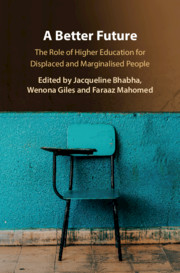Book contents
- A Better Future
- A Better Future
- Copyright page
- Contents
- Figures
- Tables
- Notes on Contributors
- Introduction
- Part I Encountering Marginalisation
- Part II Deconstructing Marginalisation
- Chapter 8 Providing Access to Higher Education for Refugees in Europe
- Chapter 9 The German Case
- Chapter 10 Colombian Distress Migrants in Ecuador
- Chapter 11 Transcending Socio-cultural Barriers
- Chapter 12 Combating the Exclusion and Marginalisation of Persons with Intellectual Disabilities in Higher Education in the United States
- Chapter 13 ‘Invisible’ Disabilities in South Africa’s Higher Education Sector
- Part III Confronting Marginalisation
- Index
- References
Chapter 12 - Combating the Exclusion and Marginalisation of Persons with Intellectual Disabilities in Higher Education in the United States
from Part II - Deconstructing Marginalisation
Published online by Cambridge University Press: 06 September 2020
- A Better Future
- A Better Future
- Copyright page
- Contents
- Figures
- Tables
- Notes on Contributors
- Introduction
- Part I Encountering Marginalisation
- Part II Deconstructing Marginalisation
- Chapter 8 Providing Access to Higher Education for Refugees in Europe
- Chapter 9 The German Case
- Chapter 10 Colombian Distress Migrants in Ecuador
- Chapter 11 Transcending Socio-cultural Barriers
- Chapter 12 Combating the Exclusion and Marginalisation of Persons with Intellectual Disabilities in Higher Education in the United States
- Chapter 13 ‘Invisible’ Disabilities in South Africa’s Higher Education Sector
- Part III Confronting Marginalisation
- Index
- References
Summary
Increasingly, students with intellectual disabilities (ID) in the United States are overcoming historical barriers to accessing traditionally exclusionary higher education. These gains undoubtedly represent a hard-fought victory for the broader disability rights movement. However, this advance has not come through enforcing the civil rights and non-discrimination statutes that generated disability rights victories in other areas or the disability-specific education laws that promoted access to primary and secondary schooling. Instead, many students with ID are accessing higher education opportunities through specialised programmes, often styled as ‘inclusive’ despite their segregated nature. Such programmes present new arenas for familiar forms of disability-based discrimination to once more manifest — such as suspect admissions criteria, second-class status and biased disciplinary procedures. Thus, despite the proliferation of inclusive post-secondary programmes, there remains an urgent social need to address barriers to full and effective participation in higher education that students with ID continue to face when navigating university and college campuses.
Keywords
- Type
- Chapter
- Information
- A Better FutureThe Role of Higher Education for Displaced and Marginalised People, pp. 268 - 291Publisher: Cambridge University PressPrint publication year: 2020
References
- 1
- Cited by

